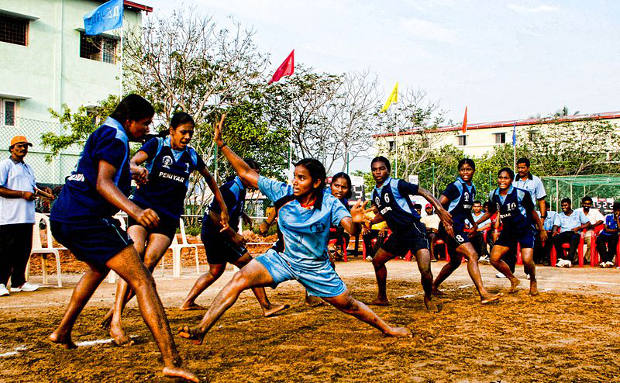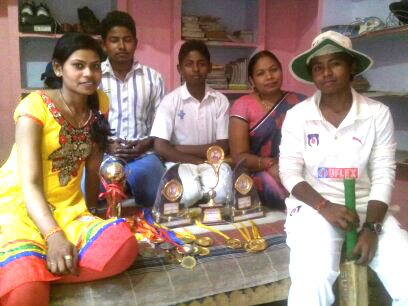In Rural India, The Sportswoman Rises--Slowly

Banda (Uttar Pradesh)/ Mumbai: With her adoring family looking on, Shobha Singh Khangar, 15, surrounded by her trophies, her cropped hair tucked into a white floppy hat, gestured at the narrow lane where they live.
"I started playing cricket at the age of six, in this very lane, with my brothers and sisters," said Khangar, dressed in cricketing whites on a quiet afternoon in Banda town on the conservative, largely poor south-eastern edge of Uttar Pradesh.
After some years, her sisters stopped playing, but Khangar played on, thanks to encouragement at school. It still wasn't easy, and parental permission, especially from her father--a head constable with the Banda railway police--was important.
Free of traditional restraints, the determined teen won district-level competitions in javelin, discus throw and kho-kho, but cricket was her first love.
Today, Khangar is the district's only female professional cricket player and is training to play for UP and hopes to make the Indian under-19 women's cricket team.

Image Credit: Khabar Lahariya
"There are very few women in this field," said Khangar. "Had it not been for support from my parents and encouragement from the school principal and my teacher, I would not have reached this far."
Across India, such support is growing--albeit slowly--and the participation of women in village, district, state and national level sports competitions has grown 328% over the past four years, according to data compiled by IndiaSpend. The rise seems meteoric, but the base is small.
Integrating sports with education is a key reason for increasing participation, as it was for Khangar. The right-to-education act of 2009 requires sporting facilities in every school, and the Central Board of Secondary Education (CBSE), a central government education system, makes sports mandatory.
This ground-up approach is producing a wealth of female sporting enthusiasm.
Source: Lok Sabha
Rural female participation in sports has increased from 249,190 in 2008-09 to 1.07 million in 2013-14, despite a drop in budgets.
This groundswell of enthusiasm reaches into mainstream sports, such as cricket.
Jhulan Goswami, Mithali Raj, Neetu David and Nooshin Al Khadeer, some of India's finest women cricket players, all come from small towns.
Jhulan Goswami is regarded by some as the world's fastest female bowler. Mithali Raj, captain of the Indian women's team, is the second-highest scorer in women's test cricket.
A good start but a drop in an IPL-dominated ocean
As Khangar's case indicates, the support of educational institutions and families is critical, but in a conservative nation, government support plays a major role.
As many of 53% of participants in India's only rural-sports programme, the Panchayat Yuva Krida Khel Abhiyan (PYKKA or Village-level Youth Sports Programme), are women. The scheme is now called the Rajiv Gandhi Khel Abhiyan (RGKA, or the Rajiv Gandhi Sports Movement).
RGKA funds sports infrastructure in villages and promotes annual competitions at the block, district, state and national level.
There is no separate budget for female sportspersons. However, a minimum expenditure of 30% is allocated to women under neutral programmes by the government.
The National Championship for Women, launched in 1975 to promote sports among women, has now been integrated with RGKA and provides the following assistance:
| Competition level | Funding For Sportswomen |
|---|---|
| District level | Rs 2.4 lakh per district (Rs 20,000 per discipline, for 12 disciplines) |
| State/UT Level | Rs 1 lakh per district for State/UT for 12 sports disciplines |
| National Level | Rs 10 lakh per discipline |
| Sports under the Rajiv Gandhi Khel Abhiyan | |||
|---|---|---|---|
| Sport | Sports at National Level | Sports for women | North East Games |
| Athletics | ? | ? | ? |
| Badminton | ? | ? | ? |
| Basketball | ? | ? | ? (optional) |
| Gymnastics | ? | ? | ? (optional) |
| Handball | ? | ? | ? (optional) |
| Hockey | ? | ? | ? |
| Kabaddi | ? | ? | - |
| Kho Kho | ? | ? | - |
| Swimming | ? | ? | ? (optional) |
| Table Tennis | ? | ? | ? |
| Tennis | ? | ? | - |
| Volleyball | ? | ? | ? (optional) |
| Archery | ? | - | ? (optional) |
| Wushu | ? | - | ? (optional) |
| Taekwondo | ? | - | ? (optional) |
| Weightlifting | ? | - | ? |
| Cycling | ? | - | - |
| Boxing | ? | - | ? |
| Judo | ? | - | ? |
| Wrestling | ? | - | - |
| Football | ? | - | ? |
Karnataka topped the list with 163,520 female participants in 2013-14 under the PYKKA/RGKA programme (refer interactive map above). Maharashtra with 158,836 female participants was second, followed by Tamil Nadu (134,790), Gujarat (101,497) and Madhya Pradesh (88,116).
But government spending can only be a start.
Over the last four years, Rs 148 crore was spent under the PYKKA/RGKA competitions. Of this, 10%, or Rs 14 crore went to sports for women. Only Rs 357 crore was released for rural sports infrastructure.
Here’s the contrast: In 2014, Rs 262 crore was spent during auctions of the Indian Premier League. That's 77% more than all the money spent over four years for sports competitions in rural areas.
The north-eastern states of Arunachal Pradesh, Manipur, Meghalaya, Mizoram, Nagaland, Sikkim and Tripura received only Rs 14.27 crore over the last four years (Assam got no money). These are states that are home to India's global sportswomen including M.C. Mary Kom, 2012 Olympics bronze medallist and a five-time world amateur-boxing champion, boxer L. Sarita Devi, silver medallist at the 2014 Glasgow Commonwealth Games, and weightlifter K. Sanjita Chanu, who won gold at the 2014 Glasgow Commonwealth Games.
Recognising the importance of sports infrastructure in what is now becoming India's sporting crucible, especially for women, the central government set aside Rs 100 crore in the budget of 2014-15 to set up a sports university in Manipur.
(This story has been produced in partnership with Khabar Lahariya, a rural, weekly newspaper run by a collective of female journalists from five districts in Uttar Pradesh and one in Bihar. Chaitanya Mallapur is a policy analyst with IndiaSpend.)
Image Credit: Wikipedia/Arivazhagan89
_______________________________________________________________________________________
“Liked this story? Indiaspend.org is a non-profit, and we depend on readers like you to drive our public-interest journalism efforts. Donate Rs 500; Rs 1,000, Rs 2,000.”


